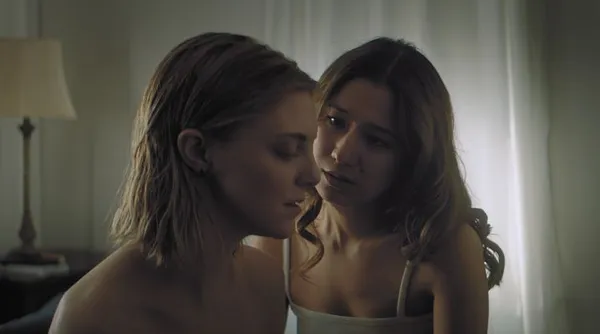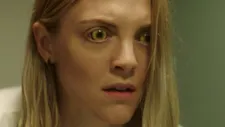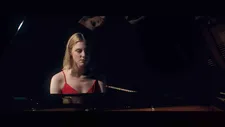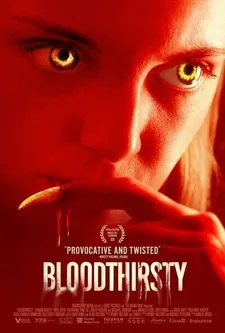 |
| Lauren Beatty and Katharine King So in Bloodthirsty Photo: Inside Out |
Screening as part of this year’s Inside Out, Bloodthirsty is a dark little tale about music, self-discovery and lycanthropy, starring Lauren Beatty as Grey, a young singer who, with her girlfriend in tow, goes to stay with record producer Vaughn (Greg Bryk) at his remote woodland studio to record her second album. It follows last year’s Bleed With Me, which starred the same actress as a young woman staying out in the woods with a friend who may or may not be a vampire. Moses’ work is hugely impressive given that she’s still at an early stage in her career, but when we talk, I feel compelled to ask how it was that she found herself making two horror films with classic monster elements set in cabins in the woods and featuring erotic connections between women back to back.
With some directors, such an opening gambit would start a fight, but Amelia sees where I’m coming from and laughs. “Yeah, I mean, I definitely wasn't expecting to make the second film so soon after the first! And I didn't write the script for Blood thirsty, so a few of those things were kind of just a coincidence. I imagine that the writer was interested in working with me because maybe there was some kind of parallel because Bleed With Me was done and they saw it when they decided to hire me.
 |
| Bloodthirsty |
“I think definitely I'm interested in the single location. I mean, it helps with budget reasons as well. But I think an isolated, single location breeds a lot of tension, especially when you have a limited cast of characters and specific dynamics. I think it leads to a lot of tension, which is great. And then, yeah, they both deal with a bit of psychological horror, maybe Bleed With Me more so, because it's very much from the main character’s perspective, whereas Bloodthirsty, it's much more like, ‘okay, this is really happening, but it's just kind of her discovering it.’ And then, to me, it's not necessarily supposed to have a queer undertone. That’s kind of a by-product of looking at kind of female intimacy. I didn't set out to have that be an undertone but I can see why that's an aspect of it. Just because I think you're looking at the closeness between these two female friends, so it makes sense. But, yeah, I would say both those were just like a coincidence.”
They do have their similarities, but they both feel very different, I say. Was she conscious of wanting to make a distinction, given the similarities?
“Yeah, I mean, I think that obviously, the biggest kind of similarity is casting Lauren again, but she was the right person for the role, so it made sense. But yeah, maybe more kind of stylistically. In terms of, you know, choices to do with the camera and stuff. They were both similar timelines in terms of the shooting schedule, but we were more limited in terms of money and crew for Bleed With Me, so that impacted the way we shot. It was with maybe a little bit more handheld [camera] and just getting what we could. It's still quite stylized, but then for Bloodthirsty, I was aiming to be a bit more specific in my choices. And there's no improv but there's some scenes where people are just kind of sitting and talking, so it's kind of a different feel. Not everything is moving the plot forward.”
Both films really put Lauren through the works. How did Amelia engage with her to get those performances?
 |
| Bleed With Me Photo: Courtesy of Fantasia |
“I think we were lucky,” she says. “We did kind of get to know each other, and that always helps to build that trust, which definitely allows actors to be a bit more vulnerable, whether that's, you know, getting covered in blood, or an emotional scene or whatever. We had actually met before I made Bleed With Me, and I kind of had her in the back of my mind for that film. And then for that film, I didn't necessarily give her a ton of direction, because the film is so centred around the main character and we see things through her eyes, so I let her make her own choices for the character, and then left her a little bit alone for that reason. And we got along really well on that shoot. And then when she came on to Bloodthirsty, she kind of knew how I worked and I think that trust was built there. And yeah, we just would talk a lot about the character. You know, there wasn't a ton of prep time for Blood thirsty, so we did what we could, but especially for that film, she's in almost every scene, it's very much her arc. So we’d really kind of think about where the character is at, at any particular moment in her journey.”
I tell her that I find it interesting that the character is suffering from mental illness, which is something that's been portrayed a lot, sometimes in problematic ways, in the horror genre. Did she feel a particular responsibility going into that?
“Yeah, I think it's a really tricky thing, because I completely agree with you that, you know, horror has a history of not always looking at those things delicately, or with nuance. I tried to think about things I've experienced, but then maybe heighten them a bit, you know? So if I felt, at times, insecure, or maybe - not suspicious, but like asking myself ‘Does that person really want to be my friend, or is there something else going on?’ And then making that more fully fledged, like paranoia. I try to relate it to my own experience as much as possible. And with Bloodthirsty, you know, we delved into it a little less, because I guess it's more of a jumping off point that maybe the world is telling her one thing but the truth is kind of different. But yeah, I think it's definitely a tricky topic to depict considering the way it has been depicted in the past.”
 |
| Grey begins to change |
There's a moment of Bloodthirsty which to me was probably the creepiest bit of the film, despite all the other things that happen, where Lauren is told that she doesn't need her pills and she should give them up. To me that that felt very much like a grooming process. Was that Amelia’s intention?
“Yeah, I mean, I guess, has an irony to it. Because Vaughn in that moment is like, right. But at the same time she’s being pulled in these two different directions, in that her girlfriend has a very different view on it, in the sense that people do take medication, there's nothing wrong with it, there's nothing to be ashamed of. So I guess it's kind of showing just these two different people pulling her in very different directions and her feeling kind of lost. But yeah, it's definitely on the surface if you don't quite know what's going on yet, in terms of her becoming a creature. That is, you know, it definitely adds to his character that he is very controlling. And that's a moment where he's doing something very, very controlling.”
It seemed to me that early on in the film, before we really how it's going to go, there’s something of a #MeToo element to it where we wonder if Grey is safe to have gone off into this isolated place with this man she doesn't know very much about...
“Yeah, I think I think it's just kind of there in that narrative and horror, where you're kind of leaving one world behind and going to another one. And even if that's just still a house in the middle of the woods, you know, it's still kind of entering a new space that's going to feel different and have that atmosphere to it. And so Vaughn and the house, I saw them as kind of like one thing, you know? They're both connected. And so they’re both creating this feeling of uneasiness. In the first little bit, you're not quite sure what's going on. But for me, it's, it's trying to build that that atmosphere as best as possible. So it's not necessarily scary, but that you're uneasy, and everything feels kind of slightly off.”
Grey is also uneasy because of the way people have started reacting to her after the success of her her first album. I ask Amelia if that’s something she has encountered in people within the industry.
 |
| What sweet music they make |
“Yeah. I mean, I think, on a personal level, when I related to in terms of character was just trying to make a second project, as ironically, I was making a second project and not really knowing what to do next. Obviously, for her, you know, she's also feeling pressures from many, many places. But yeah, it's kind of difficult the second time out, you know, and also just trying to like find your, find your footing as an artist and think about what you want to say. So I definitely related to that aspect of the character.”
Going back to what we discussed before about vulnerability, it seems to me that this is a story about the artistic process and about the vulnerability that that involves, and I wonder if Amelia was trying to parallel that with Grey’s experience of change as she's becoming something else.
She concurs, but after thinking for a moment, says “I think it's more about how in order to unlock this next level of creativity, she had to open up this dark side of herself. And once it's open, it can't be closed. And then obviously, by the end of the film she’s crossed a line that cannot be uncrossed. So for me, the way I saw the metaphor was the way art can be inherently selfish in some ways, the pursuit to make art. And how a lot of times, maybe you leave the people around you, you kind of forget about them. And I think that's shown through her relationship with her girlfriend. She goes in a direction and she gets what she wants in terms of making a record that she's happy with, but obviously, she's done something devastating, and she's unlocked something that she knows she has to live with forever.”
It's a very different way to approach the werewolf myth. I as what her favourite werewolf films are and if any of them influenced her choices.
“I'm a big fan of An American Werewolf In London. Naturally. So that was always the first thing I thought of, and definitely as far as the transformation scene went. It was a big inspiration in terms of how I wanted to really feel the pain of the character, you know, rather than some kind of quick like, ‘Oh, you know, now they're a werewolf.’ And it also helps to use practical effects and versus doing something with CGI. And then Ginger Snaps, as well. I really like that film and it has a similarity in terms of the coming of age thing. They don't really follow the normal rules that we're used to in werewolf lore, but I tried to embrace that as much as possible. So, you know, never showing the full moon and taking away some of the imagery we usually see in order to express it in a different way. So this is much more a kind of emotional thing. I think it's always fun to play around with these kind of icons.”
 |
| Bloodthirsty poster |
What about the scenes which we see from the perspective of a wolf, in Grey’s dreams?
“I was kind of trying to have this parallel between her writing the really beautiful music, and then this kind of more animalistic thing, but them almost being interconnected, and also how one thing unlocks the other, you know, so she drinks the blood in the fridge that unlocks something for her creatively. For when she's kind of animalistic, we just played around with body language changing, in terms of Lauren’s performance. And a little bit of sound design too, maybe hearing a bit of a kind of growl when you wouldn't normally hear a growl, to play with something kind of simmering, I guess.”
I mention that I was impressed by how she integrated the sound design and the use of music in the film, because music is a central part of who Grey is.
“Yeah. Most of the music was written before I came on board, and then some was written in pre production in terms of the songs that Lauren wrote that are sung in the film. And then the score was done by Michelle Osis. So we were able to kind of record most of that on set, Lauren singing since we were actually in a recording studio and we had all the right microphones and stuff. So most of the stuff was done on the day in terms of recording, which is always really fun as a director, to get that on the day. And then it was a matter of sometimes having her just singing and it feels very kind of” – she hesitates - “not empty, but more minimalistic, and then sometimes having the score come in a little bit while she's singing as well, to feel that emotional beat. So kind of a balance that Michelle and I worked on.
“The sound design was a really, really fun process because of that extra level, especially when you're designing a creature, you have the visual design but what they sound like is super important. And again, I was trying to move away from any kind of howls or things like that and find sounds that were more harsh or guttural. And then the transformation was probably the most exciting for the sound designer because it really elevated it. You know, trying to think about sounds of bones breaking or creaking or crushing, or very harsh noises. So that was a really fun process.”
So now that she’s completed that second feature, what happens next? Will she be staying with the same kinds of themes?
“Yeah, I definitely feel a bit kind of like, I don't really know what to do next. I imagine I probably will say within the horror genre. I'm developing a script with with a friend that she she wrote, but in terms of my own writing, I'm not too sure. It definitely has been a crazy couple years and I’m still processing having done these two projects, but I imagine I will probably stay within female driven horror because I definitely love it.”





















